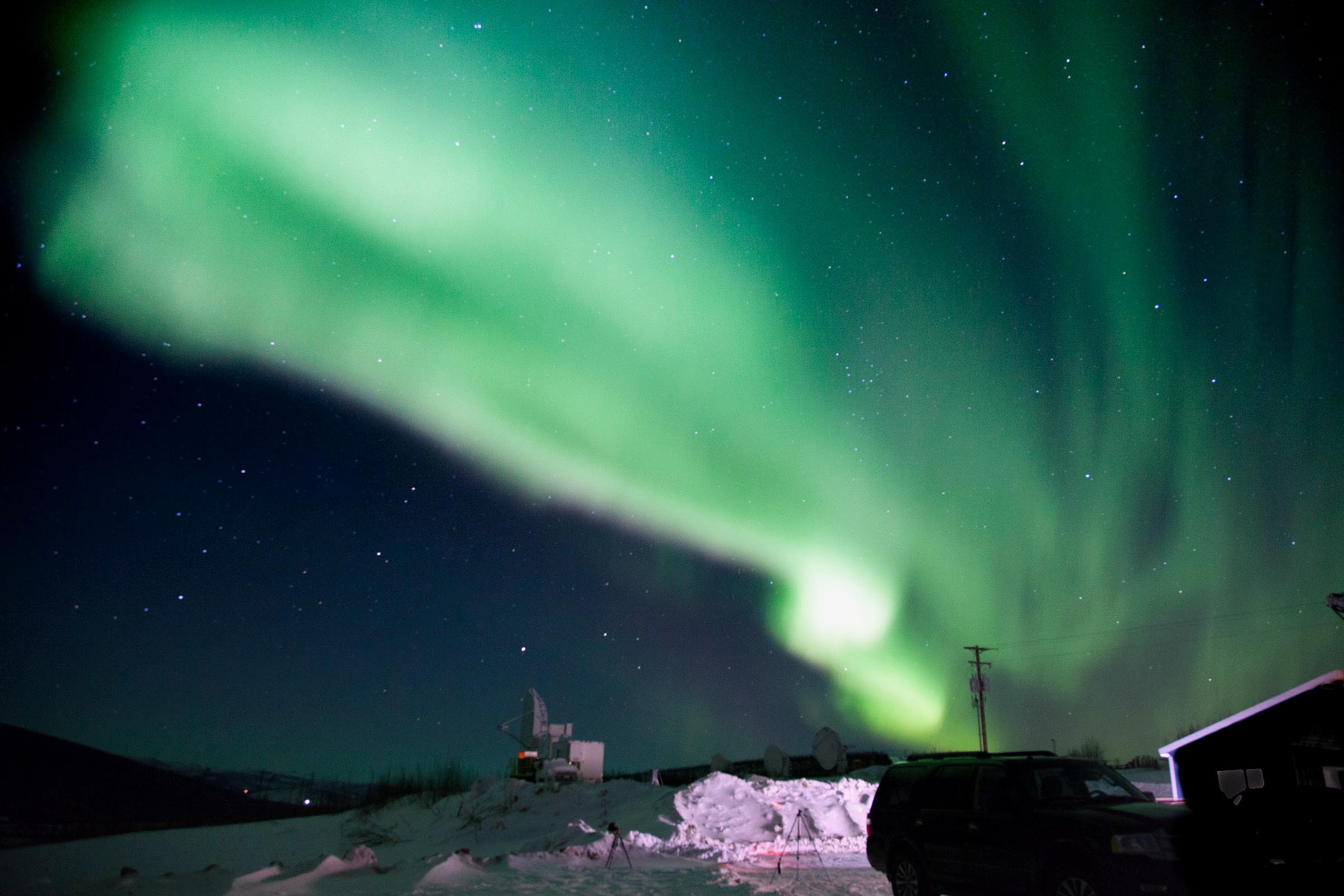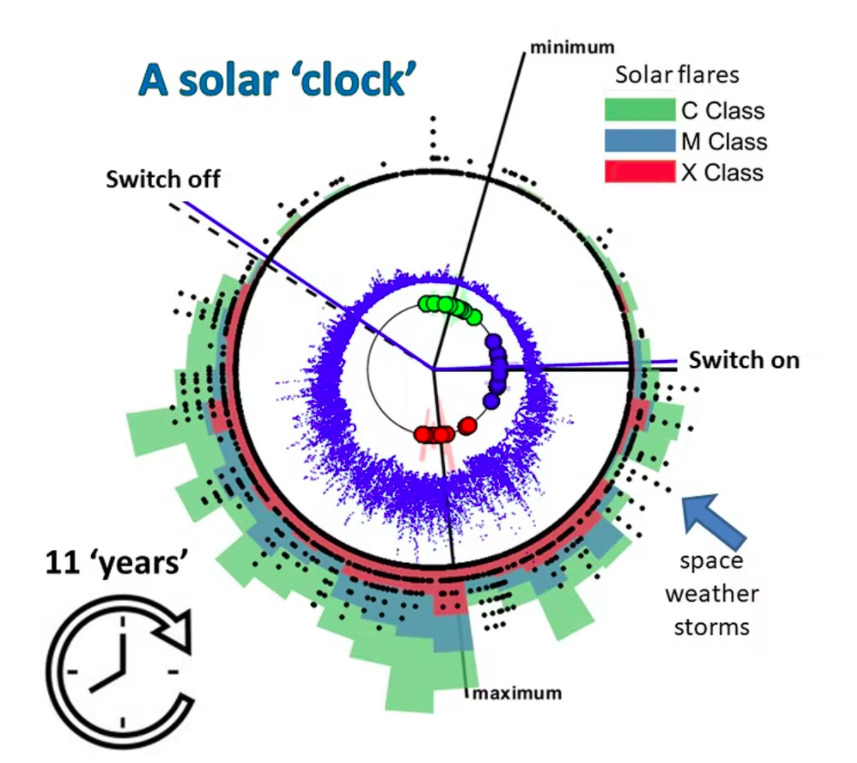
Why are we seeing more northern lights this year?
Our sun has a cycle of activity and as it becomes more active, there will be more sightings of the northern (and southern) lights.

This article was originally published at The Conversation. The publication contributed the article to Space.com's Expert Voices: Op-Ed & Insights.
Solar cycle 25 is kicking off in style. Our sun has a cycle of activity and as it becomes more active, there will be more sightings of the northern (and southern) lights. That is what is happening this winter.
As well as emitting sunlight, our sun has an expanding atmosphere made of charged particles and magnetic fields. This high-speed solar wind blows over Earth, but Earth has its own magnetic field (imagine a large bar magnet with its poles roughly aligned with geographic north and south) and this can deflect the solar wind. This magnetic barrier is weakest at the poles of the "bar magnet" so that we tend to see auroral displays at high latitudes. The bigger the space weather storm, the deeper charged particles can penetrate the magnetic field of Earth, so that during intense events, the northern lights are seen at lower latitudes.
In 2022, we have seen some spectacular auroral displays, natural light displays in the sky in more places than is usual across the United Kingdom.
Northern lights are also being spotted in northern England this winter which is a tell-tale sign of increasing solar activity.
Related: Watch auroras paint the sky above Earth in these stunning astronaut photos and video
Why is this happening now?
Solar flares erupt from the surface of the sun, and these expand outwards as coronal mass ejections that carry energy in both their charged particles and magnetic fields. If a coronal mass ejection collides with Earth, it interacts with Earth's magnetic field, driving a geomagnetic storm.
Get the Space.com Newsletter
Breaking space news, the latest updates on rocket launches, skywatching events and more!
Earth has a roughly dipolar magnetic field, with a tail stretched out by the solar wind, and with the poles near to the geographic north and south poles, and it is at these high latitudes that the charged particles can travel to reach Earth’s atmosphere more easily.
Charged particles strike the upper atmosphere (ionosphere), causing it to glow, creating a beautiful display, the aurora borealis or northern lights. These are not just beautiful displays. These extreme space weather events can effect a wide range of systems, from power supplies, aviation, satellites, and radio communications.
Space weather
These effects can induce unwanted currents in any electrical power grid, causing damage and in extreme cases power cuts. The ionosphere is also disturbed, affecting communications, and further out in space, where the charged particle environment becomes more energized, can damage satellites.
The sun has a cycle of activity, in active years, solar flares and coronal mass ejections are frequent, while in quiet years, they rarely occur. The solar cycles are on average about 11 years long but actually vary both in duration and in the level of activity. It's possible to track the level of solar activity by counting sunspots — dark patches on the surface of the sun which correlate with likely occurrence of solar flares. The last few years have been a period of low activity and solar minimum — the minimum in the number of sunspots — was observed at the end of 2019.

We are now in the rising phase of the new solar cycle of activity as the number of sunspots seen each day is steadily increasing. We can also see increasing solar flare activity. There are three categories of solar flares, measured by their X-ray emissions: X-class flares are big; they are major events that can trigger continental scale radio blackouts and city-wide power outages. M-class flares are medium-sized; they can cause brief radio blackouts that affect Earth’s polar regions. C-class flares are small with few noticeable consequences here on Earth.
On Oct. 9, 2021, an M-class solar flare erupted sending a coronal mass ejection that hit Earth on Oct.12, triggering a moderate geomagnetic storm. On Nov. 3 and 4, we saw the most intense geomagnetic storm to hit Earth since September 2017.
Since each solar cycle is unique both in duration and activity level, it is difficult to predict how active the next phase of the new solar cycle will be. Recently research mapped this irregular cycle in time onto a uniform solar cycle clock, shown in the graphic above.
We can read back from the sun clock to see where (or when) we are in the solar cycle, so as well as helping tourists to plan their Nordic holidays to see the northern lights, this graphic could also help power grid operators who need to schedule critical maintenance during periods of quiet space weather.
This article is republished from The Conversation under a Creative Commons license. Read the original article.
Follow all of the Expert Voices issues and debates — and become part of the discussion — on Facebook and Twitter. The views expressed are those of the author and do not necessarily reflect the views of the publisher.
Join our Space Forums to keep talking space on the latest missions, night sky and more! And if you have a news tip, correction or comment, let us know at: community@space.com.

Sandra Chapman is primarily but not exclusively a plasma physicist working on non-linear and complex systems in astrophysics and in the laboratory. She is a professor of physics and director of the Centre for Fusion, Space and Astrophysics at the University of Warwick and Adjunct Professor of Mathematics and Statistics at the University of Tromso. She read Physics on an Exhibition Scholarship to Imperial College, London and her interest in nonlinear systems began with her PhD work (also at Imperial College). Her early work was recognised with the COSPAR Zeldovich Medal (commission D) and the EGS Young Scientists' Medal. She was selected to give the 2014 Royal Astronomical Society James Dungey Lecture and the 2020 American Geophysical Union Fall Meeting Ed Lorenz Lecture, was part of a team awarded a 2021 Lloyd's of London Science of Risk Prize, and has been awarded the 2022 Royal Astronomical Society Chapman Medal. Sandra was a 2017/18 Fulbright-Lloyd's of London Scholar, a 2003/4 Fellow at the Radcliffe Institute for Advanced Study Harvard and has also been granted Research Fellowships by the Nuffield Foundation and the Japan Society for the Promotion of Science. She has published over 190 papers in the refereed literature and a textbook on Electrodynamics. She is also an artist who works to bridge the ‘arts- science divide’ and has held a NESTA Dreamtime fellowship – working as an artist with the British Antarctic Survey in Antarctica.









